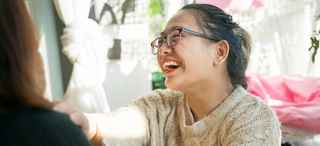How Is Cerebral Palsy Treated?
There is no cure for cerebral palsy, but early intervention can significantly improve the lives of those who have the condition. Treatment for cerebral palsy depends on the specific symptoms and needs of each person, and those needs may change over time.
At UT Southwestern, we bring together a team of specialists trained in treating children and adults with cerebral palsy. Our team includes:
- Physicians, such as pediatric neurologists, physiatrists, orthopedic surgeons, neurosurgeons, and GI specialists
- Child developmental specialists
- Mental health specialists
- Occupational, physical, recreational, and vocational therapists
- Speech-language pathologists
- Adaptive equipment specialists
- Orthotics specialists
These experts work together with patients and their families to develop a personalized treatment plan to improve motor skills and overall function. Each treatment plan is based on the individual’s symptoms and needs.
Medications are often used to lessen muscle tightness, improve functional abilities, treat pain, and manage drooling, complications related to spasticity, or other symptoms. These medications can include:
- Muscle injections with botulinum toxin or nerve injections with phenol to treat the tightening of a specific muscle
- Oral muscle relaxers
- An intrathecal baclofen pump to manage severe spasticity or dystonia
- Medications or botulinum toxin injections to reduce drooling
Rehabilitative therapies often play an important role in treating cerebral palsy, including:
- Physical therapy such as muscle training and exercises to improve strength, flexibility, balance, motor development, and mobility. Physical therapists also guide parents on how to safely care for their child's everyday needs at home and continue muscle training and exercise at home between therapy visits.
- Occupational therapy to develop independence in daily activities and routines at home and school and in the community. Occupational therapists may recommend adaptive equipment such as braces, splints, walkers, wide-based canes, standing and seating systems, or electric wheelchairs.
- Speech and language therapy to improve speech or to learn communication through sign language or devices such as a computer and voice synthesizer. Speech therapists can also address difficulties with eating and swallowing.
- Recreational therapy to improve sensory and motor skills. Both adults and children benefit from regular physical activity.
Surgical procedures may be needed to lessen pain, improve mobility, or make it easier to use a walker, braces, or crutches. These treatments include:
- Orthopaedic surgery to address joint or bone deformities, to lengthen muscles, or to lengthen or reposition tendons
- Neurosurgery to cut nerve fibers to specific spastic muscles (selective dorsal rhizotomy) and intrathecal baclofen (ITB) pump placement, or deep brain stimulation (DBS) surgery
Other treatments may be recommended for other issues such as seizures, osteoporosis, and problems with mental health, sleep, oral health, nutrition, incontinence, vision, or hearing.






